Close ties




At Atlanta’s Ponce Center, relationships are at the heart of clinical and research programs for people with HIV.


WINTER 2013
PATIENT CARE, RESEARCH, AND EDUCATION FROM THE WOODRUFF HEALTH SCIENCES CENTER
RE-THINKING HIV VACCINES 14 WHY WE STILL SMOKE 18 Q&A ON HPV 22 SE HABLAS ESPANOL 26
Emory Health
Executive VP for Health Affairs
S. Wright Caughman, MD
Editor
Rhonda Mullen
Art Director
Peta Westmaas
Director of Photography
Jack Kearse
Graphic Designer
Linda Dobson
Production Manager
Carol Pinto
Web Specialist
Wendy Darling
Advertising Manager
David McClurkin
Executive Director, Health Sciences
Creative Services
Karon Schindler
Associate VP, Health Sciences
Communications
Vincent Dollard
Emory Health is published quarterly for Emory neighbors and the community as well as faculty, staff, affiliates, and friends of the Woodruff Health Sciences Center of Emory University. Produced by the Health Sciences Communications Office, the magazine is made possible by support from the Robert W. Woodruff Health Sciences Center Fund.
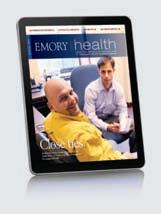
Send all correspondence to Emory Health, 1440 Clifton Road, Suite 150M, Atlanta, GA 30322; call 404-727-8166; or email rhonda.mullen@emory.edu. To see extra multimedia features online, visit emoryhealthmagazine.emory.edu.
FROM THE EXECUTIVE VP
To a healthy new year
as we enter a new year, Emory’s Woodruff Health Sciences Center (WHSC) also enters an exciting time of transition. In January, Christian Larsen became the new dean of the Emory School of Medicine, vice president for health center integration at the WHSC, and chair of the Board of Directors of The Emory Clinic. We are lucky that Dean Larsen has had a long career at Emory— first as an undergraduate, then as a medical student, surgical resident, transplant center director, and chair of surgery. He brings more than 20 years of service as a team builder, a creative problem solver, and a visionary leader to his new role. We also are lucky that Thomas Lawley, who retired from the deanship after 16 years in the position, will continue to serve on the Emory medical faculty.
The appointment of Dean Larsen is just one of many reasons that we have to be excited about what’s in store for the coming year.
As the founding director of the Emory Transplant Center in 2001, Larsen built it into one of the foremost research and clinical transplantation programs in the world. I can sense the excitement across campus as he steps into leadership roles that will bring together people from throughout the WHSC and Emory Healthcare to create synergy and solutions to meet today’s complex health challenges.
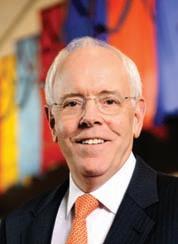
As you’ll see in this issue of Emory Health, the appointment of Dean Larsen is just one of many reasons that we have to be excited about what’s in store for the coming year. For example, our faculty and staff continue to take innovative, compassionate approaches to the fight against AIDS, and we’re making real inroads. Articles in this edition highlight the work of clinicians and nurses at the Ponce de Leon Center with HIV patients, along with a group of Emory scientists who are searching for an HIV vaccine.
Indeed, we have many reasons to be excited about the year ahead and to be grateful to all the faculty, staff, students, and supporters who make our lifesaving work possible year in and year out.
Best wishes for a happy and healthy 2013, Wright Caughman
Please share your feedback at evphafeedback@emory.edu. Send letters to the editor to rhonda.mullen@emory.edu
 Download our iPad app.
Download our iPad app.
2013
Letters 2
NEW AND NOTEWORTHY

On our radar 3
3 | Encouraging breastfeeding 3 | A red dress recognition for heart disease research 3 | Discovered: a new Alzheimer’s gene 3 | Modern day treatments for leprosy 4 | Bringing health resources to Northwest Atlanta

5 | Triple organ transplant 5 | A landmark HIV research program turns 25
6 | A preview of Emory’s new VP for health center integration

6 | Communicating risk clearly
Close ties 8


At Atlanta’s Ponce Center, relationships are at the heart of clinical and research programs for people with HIV.

Navigating a complex maze 14 What we don’t know about HIV may help us find a vaccine.
Why do we still smoke? 18
We know it’s bad for us, but 19.8% of Americans can’t quit. How Emory is tackling this health hazard.

Q&A on HPV 22
Emory researchers are answering important questions about HPV and its controversial vaccine.

Interpreting health 26
Emory student volunteers are improving health care, one word at a time.

Tie a pink ribbon 28
The Glenn family builds on a legacy of supporting breast health and breast cancer research programs at Emory.

PATIENT CARE, RESEARCH, AND EDUCATION FROM THE WOODRUFF HEALTH SCIENCES CENTER
MORE Volume 6, No. 1 Visit us online at emoryhealthmagazine.emory.edu. Send letters to the editor to rhonda.mullen@emory.edu. 213001-1
WINTER
FEATURES AND
8 26
14
18
© 2013 Photo Researchers, Inc. All Rights Reserved.
Thank you so much for the story about Christopher. It brought tears to my eyes, as I remembered holding my sweet granddaughter, Lauren, for the last time. She was born in 2004. As you may know, the state of Georgia did not begin routine testing for fatty oxidative disorders until January of 2005. At 14 months, Lauren died after a week-long acute illness. The post-mortem diagnosis was MCADD, or medium-chain acyl-coenzyme A dehydrogenase deficiency—a disorder similar to Christopher’s that requires strict dietary and nutritional diligence. Lauren’s diagnosis had not been recognized by her pediatrician.
I am glad that you publicized this little boy’s story and hope you will continue to encourage people to donate to the research needed to help combat these disorders. I am also grateful for Dr. Singh and others like her in the Emory metabolic genetics program.
Doreen Henricks
Cardiac Cath Laboratory
Emory University Hospital
I am Christopher Harry’s uncle, and I am so pleased to see this article featuring him. As a family, we are deeply grateful to the staff of Emory for sustaining his life over these past few years. Thanks to this article, I can point people who have prayed for this little guy since the day he was born to a well-written narrative that will allow them to glimpse into his world.
Christopher certainly lights up any room he is in, and we are thankful for your part in keeping that light shining.
Richard Gardner Ringgold, Virginia



I’m an active alum of the Rollins School of Public Health (class of ’97). I was saddened, embarrassed, and overall shocked to see the recent cover of Emory Health magazine.
To showcase a child on a bike without a helmet is a major oversight by your staff, especially given that we have a School of Public Health in our portfolio. I was very surprised that this even made it to the editors’ table. We have come so far in the promotion of helmet use for all ages that this cover is unacceptable! Emory knows and should do better.
 Brigette Ulin
Acting Director, Office of National Prevention Strategy Centers for Disease Control and Prevention
Brigette Ulin
Acting Director, Office of National Prevention Strategy Centers for Disease Control and Prevention





EMORY HEALTH 2 LETTERS TO THE EDITOR Your thoughts? The Emory Clinic is changing inside and out. Visit us online to meet the last living Clinic founder. FALL 2012 PATIENT CARE, RESEARCH, AND EDUCATION FROM THE WOODRUFF HEALTH SCIENCES CENTER HE BIKES, PLAYS BASEBALL, DANCES, DRUMS, AND READS. BUT LIVING WITH A RARE METABOLIC DISORDER MAKES THIS ORDINARY 4-YEAR-OLD EXTRAORDINARY. 6 SENIORS SHARE LESSONS ON AGING 18 AN EMORY ETHICIST PONDERS HEALTH CARE REFORM 22 ■ ■ ■ ■ ■ ■ ■ ■ ■ ■ ■ ■ ■ ■ ■ We like to hear from you. Send us your comments, questions, suggestions, and castigations. Address correspondence to Emory Health magazine, 1440 Clifton Road, Suite 150M, Atlanta, GA 30322; call 404-727-8166; or email rhonda.mullen@emory.edu. Fall 2012 issue
Baby on board: Emory University Hospital

Midtown is one of only 90 hospitals in the country and seven in Georgia to participate in a new national effort to improve breastfeeding rates in states where rates are currently the lowest. Although breastfeeding is one of the most effective preventive health measures for infants and mothers, half of the babies born in the United States are given formula within the first week of life. The initiative, Best Fed Beginnings, seeks to reverse the trend by dramatically increasing the number of hospitals implementing a proven model that supports a new mother’s choice to breastfeed.
Treating leprosy in Georgia:
Have a heart:
Emory’s Leslee Shaw is the recipient of a Red Dress Award from Woman’s Day, in recognition of her work to improve the way doctors diagnose and treat heart disease in women.

You may be unfamiliar with Hansen’s disease. It is rare in the United States, with currently only 6,500 cases nationwide. But you’ve probably heard of leprosy—the biblical scourge that was feared to be highly contagious, and that causes skin sores, nerve damage, and muscle weakness. They are one and the same.
Emory clinicians have treated patients with Hansen’s disease for years, and recently, the National Hansen’s Disease Program (NHDP) designated Emory Healthcare’s TravelWell clinic as one of only 16 federally supported outpatient clinics to treat patients in the United States and Puerto Rico. TravelWell is the only NHDP site in Georgia.
Today we know that Hansen’s disease is not highly transmissible, is very treatable, and, with early diagnosis and treatment, is not disabling. However, because it is rarely seen, the condition often goes undiagnosed or is diagnosed incorrectly, increasing the risk of complications. When it is caught early, doctors can prescribe antibiotics and prevent major nerve damage.
Alzheimer’s discovery:
Researchers have identified a new genetic variation that increases the risk for late-onset Alzheimer’s disease by a factor of three. The finding, published in the New England Journal of Medicine, is the result of an international collaboration between deCODE genetics in Iceland, Emory’s Alzheimer’s Disease Research Center, and institutions in Germany, Norway, and the Netherlands. Although rare, the new variant is important because it adds to a growing list of genes linked to Alzheimer’s disease, and it provides clues to causal mechanisms.
The mutation is in a gene, TREM2 (triggering receptor expressed on myeloid cells 2), which is expressed in microglial cells and appears to regulate inflammation in the brain. These findings suggest that altered microglial function and inflammation are risk factors for Alzheimer’s disease.
Winter 2013 3 ON OUR RADAR New and noteworthy
Health dateline: Northwest Atlanta
families in this corridor. Groups such as Charitable Connections, Healing Community Center, Ben Massell Dental Clinic, and Community Building Coalition of Northwest Atlanta, which Emory has long supported, are working together to find free or low-cost medications and health care for those at the lowest income levels.
“We bring together resources to help solve health, transportation, and other community issues and create healthy hubs in Gloria’s community,” says Carolyn Aidman, UHI senior program associate. For example, the Emory Sustainability Initiatives Fund recently funded a transit study by UHI to develop a Labor Limo to provide women in labor with nonemergency transport to the hospital.
“Health outcomes in inner
Imagine a single mom named Gloria. She has four small children and lives in Northwest Atlanta—an area once active with industry that is now an economic desert. Gloria needs groceries but has no transportation. Her local shopping choices are the bodega on the corner or a package store down the block.

A “ride man” will drive her to the grocery store a few miles away for $10 to $14 each way, but Gloria can ill afford the $28 fare. Even if she gets a ride with a friend, she has to bring along her four children because she lacks money for child care. The next problem is returning home with the children and the groceries.
Gloria is hardly alone in her struggles. Last year, 85% of the people living in her Section 8 apartment complex in Northwest Atlanta were unemployed. This year the number has risen to 97%.
The Emory University Urban Health Initiative (UHI)—a collaboration between Emory’s medical school and the Center for Community Partnerships—is organizing efforts to help people like Gloria who cannot get help on their own. To support and re-invigorate the Northwest Atlanta neighborhood and provide needed services, Emory, Morehouse College, Georgia State University, and the city of Atlanta, among others, are collaborating with local community organizations, residents, teachers, and leaders to change the trajectory for the children, youth, and
city Atlanta are as bad as anywhere in the world,” says Emory pediatrician and neonatologist William Sexson, a UHI senior adviser. “Our infant mortality rate is one of the worst in the country. That is an Atlanta problem and a Grady Hospital problem. We own this problem.”
Among other projects in Northwest Atlanta, faculty and students from Emory’s Rollins School of Public Health have conducted needs assessments in Section 8 housing and grocery stores. Volunteers have educated local residents about nutritious foods in a neighborhood where obesity, hypertension, and diabetes are widespread. Emory otolaryngologist and UHI co-director Charles Moore has developed a local clinic, the Healing Community Center, to provide medical services nearby.
Data collected on low birth-weight babies also allows the project to demonstrate accountability, says Sexson. “As a neonatologist, I take care of small babies. We use geocoding to determine, within several hundred yards, where very low-weight babies come from. This coding can show us where we need educational efforts, where the problems are. In this day and age of limited resources, people want to know whether projects such as ours work, and whether we spent our money wisely,” Sexson says. Sally Wolff-King
EMORY HEALTH 4 ON OUR RADAR New and
noteworthy
Record breaking transplant
Following a lifetime battle of congenital heart complications, Stephanie Lindstrom, 38, needed a new heart and a new liver. Then the mother and former marathon runner contracted cytomegalovirus, and her condition worsened. Placed on dialysis and breathing machines at Emory University Hospital, she now needed a new kidney too.
Double transplants involving the heart and liver are extremely rare, with fewer than 60 performed in the United States. Triple organ transplants are even more rare, with none ever attempted in Georgia. But that procedure was Lindstrom’s last hope.

In July, Emory surgeons Brian Kogon (assisted by David Vega), Stuart Knechtle, and Andrew Adams transplanted a heart, liver, and kidney from the same donor to Lindstrom in two consecutive operations. She returned home to South Carolina after a three-month recovery. “I am so grateful to Emory,” Lindstrom says. “These transplants have given me a new lease on life.”
want more? To see a video about the historic transplant, visit bit.ly/tripleorgantransplant
What Rwanda has taught us about HIV testing
largest study of heterosexual “discordant” couples in the world. (In discordant couples, only one partner is HIV-positive.)

The first mobile HIV testing lab in Africa was based at a card table.
“I’d drive up to the hospital in a beat-up Jeep with my lab equipment and set up a card table in the open-air waiting area,” recalls Susan Allen, who began her research in Kigali, Rwanda, in 1986.
Allen’s subsequent discovery that almost one-third of the pregnant women whom she tested had antibodies against HIV led to a follow-up project, supported by the NIH, that studied not only the women but also their spouses.
What started as Projet San Francisco has evolved into the Rwanda Zambia HIV Research Group, the longest-running and
In 2012, the project marked its 25th anniversary with a conference opened by Rwanda’s First Lady Jeanette Kagame (pictured with Allen at left). “What began as a humble effort in Kigali 25 years ago, has grown to become an international advocate for affordable and effective HIV prevention, a world leader in vaccine development efforts, and a respected partner in global health,” Kagame told the New Times, a daily newspaper in Rwanda.
During the Rwandan genocide in 1994, many of the participants in the original study were killed, along with half the staff. For safety, the project relocated to Zambia. It took several years before Rwanda stabilized enough to convince funding agencies that it was safe. Eventually, the Rwanda Zambia HIV Research Group went on to conduct the first HIV vaccine trials.
Allen’s early finding that many of the women tested lived in a discordant
relationship surprised scientists at the time. Since then, her research has provided critical data about HIV transmission and prevention methods and this year led to the adoption of guidelines by the World Health Organization that couples should get tested for HIV together.
“The couples testing policy is something to celebrate,” Allen says. “Without the work in Rwanda and Zambia, this would not have happened.”
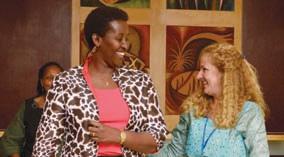
The new guidelines were designed to help partners in a stable relationship work together to prevent the uninfected person from getting the virus. Lowtech, inexpensive prevention methods like couples testing and counseling plus condoms are just as important as antiretroviral therapy in this effort—and far more affordable and sustainable in the long run than drug-based strategies, Allen says. The most important research effort now is to develop a vaccine.—Quinn Eastman
(See related story on page 14.)


Winter 2013 5
The relativity of risk
What does 1 in a million mean, if the patient is you?
Dermatology patients often seek treatment for skin conditions that may be uncomfortable but are not life threatening. Some of the medications used to treat such conditions may be toxic. Emory dermatologists Robert Swerlick and Benjamin Stoff began to wonder whether their patients fully understood what they were telling them about risk. To explore the question, they have designed a research project that has implications well beyond their specialty. With the help of Emory medical students Lucy Fu and Aaron Rosado, they are analyzing how doctors communicate with patients and each other, what language they use in doing so, and how effective those communications are.
“Sometimes even though the legal standards for communicating risk are met, ethical standards are not,” Stoff says. “As doctors, our language often is not specific.”
He points to a 1991 research project [Merz, Druzdzel, and Mazur] in which investigators collected information about the ways doctors conveyed patient risk while testifying in court. The doctors who testified often used “low” or “high” to identify the level of risk, but later when asked to quantify what they meant, they differed wildly on meaning. By “low risk,” some doctors had in mind one patient in 10, while others thought low meant one patient in 10 billion. The numbers for “low” risk overlapped with “high.”
The observation led Swerlick and Stoff to other questions: Do verbal terms really mean anything? How prevalent is this problem? Can
patients differentiate between risks deemed rare vs. common, likely vs. unlikely, or frequent vs. infrequent? “If the terms lack standard definitions, then I think we need a paradigm shift from verbal expression to one that has more meaning,” Stoff says.
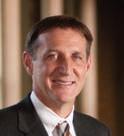
He and Swerlick have identified barriers that potentially can interfere with patients’ understanding of what their doctors are communicating, including poor comprehension of numbers, imprecise language, and risk framing (providing a context). “Patients, especially the elderly, have difficulty understanding probabilities, particularly those expressed as fractions or percentages, which is a format often used by health care providers,” Stoff says. A misunderstanding of the numbers can compromise an accurate interpretation of risk.

Framing also plays an important role, says Swerlick, the Alicia Leizman Stonecipher Chair of Dermatology. “Depending on how I present options to any given patient, I basically can talk anyone into anything. However, if all patients within a given clinical context whom I counsel make the same decision, I believe I am not communicating in a way that presents them with any real choice.”
Stoff compares patients’ perceptions of risk to their fears of dying in an airplane crash or an automobile accident. “Even though the risk of death from driving is more than 100 times greater than dying in a plane crash, that risk often seems more tolerable to people because driving is a part of everyday life and is under greater control of the individual.”
By identifying where language and current communications tools fall short in the health care environment, the researchers hope to address these limitations to promote the ability of patients to be more self-directed agents. After all, patients who achieve this autonomy in decision-making, working together with caregivers who effectively frame and communicate risk, together can make the best decisions and get the best outcomes. SWK
EMORY HEALTH 6 ON OUR RADAR New and noteworthy
Now that we have electronic health records and the ability to integrate data from all sorts of streams— financial data sets, administrative data sets, health outcomes data sets—we can marry those together. With that marriage, we can redesign health care.”
—Christian Larsen, Dean of the Emory School of Medicine and VP for Health Center Integration. Look for more of the new dean’s ideas on applying integration throughout the Woodruff Health Sciences Center in the spring issue of Emory Health.
Juris Master
FOR WORKING PROFESSIONALS
• Customize your studies to meet your individual career needs
• 24-credit-hour program
• Complete your degree full-time or part-time
• 15% Founder’s Scholarship for Emory University and Emory Healthcare employees
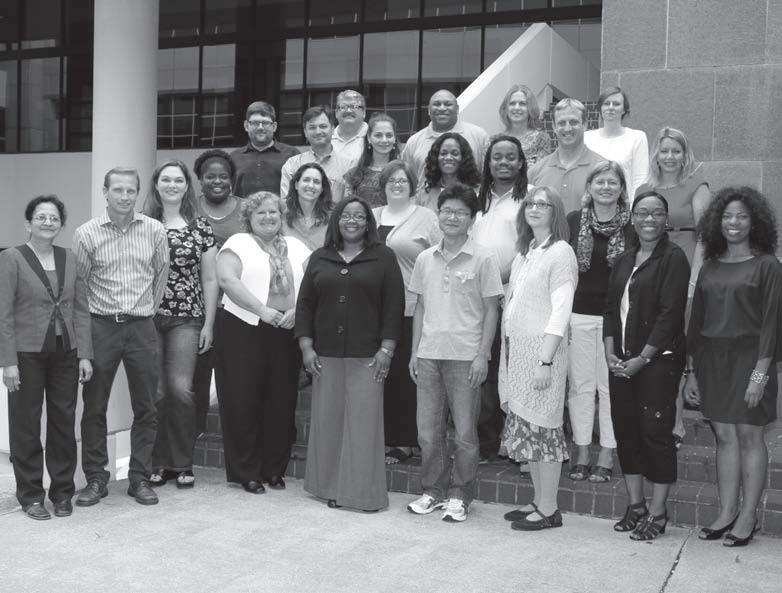
CONGRATULATIONS TO OUR INAUGURAL CLASS
Law School:
It isn’t just for lawyers anymore.
Learn more at www.law.emory.edu/jm
ADVERTISEMENT
1st Row (l-r): Kalpana Rengarajan, Emory University; Dave Williams, Georgia Tech; Wendy Wright, Emory University, Emory Healthcare and Children’s Healthcare of Atlanta; Jo-Ann House, Emory Transplant Center; Shaneesa Ashford, Emory University; Gukseop Yun; Yael Levy, The Times of Israel; L’Bertrice Hopson, P.E.N. Television Inc.; Thanicia Childs, Emory University. 2nd Row: Tye Tavaras; Cindy Mayz, Emory University; Amy Mansfield, Kilpatrick Townsend; Paula Scotman, Emory University; Tarik Johnson; Pam Terry, Emory University; Cyndi Romero, Enercon Services. Top Row: John Kosky, Emory University; Octavian Blaga, Tenet; Ed Moseley, Emory University; Mariam Iobidze; John Holmes; Patricia Olinger, Emory University; Steve Nelson; and Adrianne Grubic, CNN.
Emory nurse Marcia Holstad has worked with some of her patients for more than a decade.

THE take-away
At Atlanta’s Ponce Center, relationships are at the heart of clinical and research programs for people with HIV.

EMORY HEALTH 8
Close ties
If you live in Atlanta, chances are you’ve passed the Ponce de Leon Center a hundred times and not seen it. The building is gray and nondescript, set a discreet distance away from its namesake street in Midtown Atlanta. Signage is intentionally poor. “There’s no question we don’t put a lot of signs up,” says medical director Wendy Armstrong.
“There


 By Dana Goldman n Photography Jack Kearse
By Dana Goldman n Photography Jack Kearse
Winter 2013 9
is still a profound amount of stigma, and if you walk in, people assume you have AIDS.”
Over the past two decades, thousands of Georgians living with HIV/AIDS have walked into this former church administrative building, donated to Grady Hospital in the early 1990s. A part of the Grady Health System and staffed by Emory doctors and researchers, this clinic serves about 5,200 people.
The patients who come here are mostly poor, and mostly minorities, working lowwage jobs and living in unstable housing situations with little access to medical care. Just 3% have health insurance, and some are illegal immigrants. Many already have progressed to late-stage AIDS by the time they make it to the Ponce Clinic, having lived with the disease for many years while it went undiagnosed and untreated.
“They’re very sick,” says Emory nursing professor Marcia Holstad, who has worked with the women’s clinic since its beginnings as a small, unhoused, volunteer-run program in 1990. “A lot of the time HIV is the least of their problems. They have issues with their children, housing, substance abuse, and depression.”
For Holstad, Armstrong, and other Emory faculty, doing this work goes beyond traditional patient care. Armstrong says that
Atlanta’s epidemic of late-stage AIDS in vulnerable populations is so profound that despite her other research interests, “it became clear that my focus has to be finding people who are affected, linking them to care, and retaining them in care. If we can’t get people into care, we’ve failed this population.”
Reducing viral loads with personal attention
That focus informs both treatment and research.
One of the country’s largest AIDS clinics, the Ponce Center is a core facility for Emory’s NIH-funded Center for AIDS Research (CFAR). At last count, the Ponce Center was hosting more than 50 studies, with results of completed research cycled back into the Ponce Center’s plans to improve clinical care of patients.
“They’re very sick,” says Emory nursing professor Marcia Holstad, who has worked with the women’s clinic since its beginnings as a small, unhoused, volunteer-run program in 1990. “A lot of the time HIV is the least of their problems. They have issues with their children, housing, substance abuse, and depression.”
research on factors that impact responses to treatment. “These are people who may have trouble taking their medications, so we identify the reasons that may happen. Do the problems have to do with financial or transportation limitations, health literacy, engagement with providers, or is it a biological reason?” he says. “We try to understand what can we do as a system, either through improving our services or through biology, for those who are already significantly challenged when they start treatment.”
Close ties to staff are encouraged, since research shows that relationships with medical providers can be a deciding factor in health decisions. After all, say staff, helping patients manage their HIV requires not just removing barriers to health care but also supporting clients as they stabilize their lives.

For example, Vince Marconi—an Emory physician who is associate medical director of the Ponce Center—sees patients and conducts
A case in point is the on-site Transition Center, a sub-clinic for patients struggling with the triple whammy of HIV, mental illness, and
EMORY HEALTH 10
Wendy Armstrong (right), Emory infectious disease specialist, directs the Ponce Center, which serves about 5,200 people who are living with HIV.
“He saved my life,” says the patient below (right) about Emory physician Vincent Marconi (left).

Winter 2013 11
Many of Hostad’s patients are so close to her that they make their appointments around the clincian-researcher’s schedule.

EMORY HEALTH 12
significant substance abuse. Armstrong and colleagues recently completed a pilot study to see if patients’ health improved when they received the Transition Center’s intensive, flexible, one-on-one model of care rather than standard treatment. The results? Patients’ viral loads of HIV went down significantly.
In a follow-up study, scientists asked patients why the Transition Center had made it easier to manage their health. It turns out that “patients there felt like they had an intimate relationship with their care, their place of care, and their care providers,” Armstrong says. They described their caregiver as “a person who cares about you and knows when you’re out on the street and when you’ve fallen out of care and knows who your family is. They may know you better than anybody else.”
Keeping patients engaged
To build on this data, researchers designed

Project Retain. In collaboration with the University of Miami, the Ponce Center is creating retention clinics for newly diagnosed AIDS patients. In the clinics, patient navigators will give personal attention and support, helping patients work out logistics of treatment and accompanying them to appointments. Researchers hope to see improved retention rates among patients participating in the program.
In another recent study, clinicianresearcher Marcia Holstad and colleagues worked with a producer to write and record

songs in a variety of genres focused on AIDSrelated adherence. Participants received MP3 players with a 70-minute program of these songs. Between songs, a DJ posed questions to health professionals about AIDS, followed by scripted AIDS-related banter with would-be callers.
In comparison with a control group, participants who listened to the music saw a decrease of HIV in their blood. But that wasn’t the end of the impact. “We had people call us after they’d listened to it asking for music videos,” says Holstad. “In our focus groups, people said they shared this music with their families so their families could understand what they were going through.” One patient used the music to help break the news of his HIV status to his family. Currently Holstad is working to convert the music project into an interactive app for a follow-up investigation.
Resurrection stories
been with for a long time are people I was able to start on medications and see them get resurrected from near death.”
“Patients [at the Transition Center] felt like they had an intimate relationship with their care, their place of care, and their care providers,” Armstrong says. They described their doctor or nurse as “a person who cares about you and knows when you’re out on the street and when you’ve fallen out of care and knows who your family is. They may know you better than anybody else in your life.”
Many of those patients now make appointments around Holstad’s schedule.
“If Marcia’s not here, we’ll wait,” they say. Holstad recalls one patient she began seeing around 15 years ago. “I got her through her pregnancy, went to her wedding, and her son is 13 now. I get goose bumps now thinking about it.”
The clinical and research outcomes at the Ponce Center belie its limited resources. The center’s primary financial support comes from state-administered AIDS grants and the federal Ryan White Care Act, which comes up for Congressional reauthorization in 2013. In the meantime, space is so tight throughout the building that exam rooms double as clinician offices. While the building is seven stories, the top two floors have not yet been built out because of funding limitations.
Still, staff and patients know that relationships are more important than the quarters in which they’re cultivated. Hundreds of Ponce Center patients choose to enroll in studies each year, in part because of the trusting, long-term relationships that they have with their care providers, many of which now span more than a decade.
“In the old days, when combination retroviral therapy just started, we resurrected a lot of people,” says Holstad. “The folks I’ve
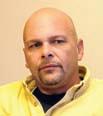

But there’s another important reason that patients participate in research, says Emory nursing professor Drenna Waldrop-Valverde. “They tell us repeatedly that they really value the opportunity to tell us their stories, something that’s often rare for people living with HIV. Although they know they personally won’t necessarily benefit from the research in any direct way, they really feel like they’re helping others and their community. A lot of people really want to know what we find out and what we learn.”
Patients are excited to give back, according to Armstrong. “People have told me, ‘I was planning my death. I never expected to be able to plan my life.’” But, through the Ponce Center, that’s exactly what they’re doing.
want more? To meet one patient who is being treated at the Ponce Center, see bit.ly/poncecenter. If you would like to support research there, please visit hwgf.org, choose donations, and designate the infectious disease program. For donations to HIV research at Emory, contact Jonathan Russell, development director in infectious diseases at the Emory Vaccine Center, jrusse5@emory.edu, 404-727-9567.
Winter 2013 13
Drenna WaldropValverde says that people with HIV value the opportunity to participate in research trials and to tell their stories.

14 EMORY HEALTH
MAZE
By Mike King n Illustration by Mark Allen Miller

Isolated outside its habitat and under the refractive prowess of an electron microscope, HIV has earned grudging respect from the scientists who study it.

HIV consists of just two strands of genetic material together with a small number of enzymes wrapped inside a viral envelope. It measures just 1/10,000th of a millimeter in diameter. The glycoprotein spikes on its outer envelope give the impression that the virus is reaching out to glom on to anything in its path, which is exactly what it is programmed to do. For a retrovirus like HIV to survive, it must get inside host cells and use the machinery of those cells to reproduce.
If nothing else, after three decades of studying HIV, we know that it can perform that task with remarkable efficiency—fusing to lymphocytes and other protective cells in the body, injecting its viral core into them, and assembling thousands of new viral cores that deploy and destroy the human immune system. If HIV is left untreated, infections—even the most common kind—run rampant, wasting, then killing, the body.
What we don’t know about HIV may lead us to the right path for finding a vaccine.

Winter 2013 15
THE take-away
N
© 2013 Photo Researchers, Inc. All Rights Reserved.
Max Cooper focuses on the antibody-producing cells of the immune system and is currently applying his research on lamprey immune proteins to studies of HIV.
Scientists at Emory and elsewhere have designed drugs to help people with HIV live longer. But the quest to eradicate the virus— to come up with a vaccine that renders it harmless—remains a major, and often frustrating, scientific challenge.
Despite a wealth of information about HIV, we still don’t know how to develop an effective protective vaccine against it, in part because the outer envelope is able to mutate in ways that are different in each infected person.
“We have made great strides in public health and prevention, in drugs and treatment protocols as well as in vaccine development—all of these being areas where Emory has made major contributions—but we may be at the point where we need to know what we don’t know about HIV,” says Emory’s Eric Hunter.
Exploring new avenues
A critical mass of investigators at Emory is
asking those questions to pinpoint the right direction forward. “It’s pretty amazing to sit back and watch how it has all come together at Emory,” says James Bradac, chief of preclinical research and development of the vaccine research program of the National Institute of Allergy and Infectious Diseases, the arm of the NIH responsible for most research involving HIV/AIDS
“I use the analogy of a baseball franchise.

Upper management made a commitment to create a worldclass vaccine center and build a solid team of great investigators. And with that has come grant money to make it happen.”
In July the NIH announced a $7 million award to three Emory investigators—Rafi Ahmed, Bali Pulendran, and Guido Silvestri—to support multidisciplinary research into triggering immune responses that could prevent or contain HIV from replicating itself in host cells. The research, funded as part of
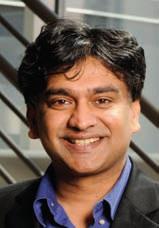
the Center for HIV/AIDS Vaccine Immunology, cuts across the work of these investigators and is illustrative of the research avenues that Emory scientists are exploring.
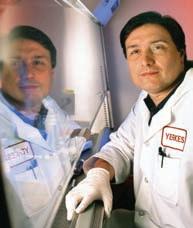
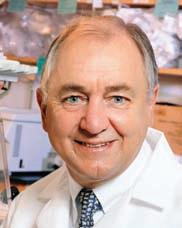

Just last year a group of Emory researchers received a grant—$6 million each year for at least five years—to explore ways to make a better HIV vaccine using the simian immunodeficiency virus (SIV) as a model in nonhuman primates. SIV has long intrigued scientists because some primates infected with the virus never progress to the disease stage. With these grants, Emory Vaccine Center scientists are working together to understand how to induce neutralizing antibody responses in virus-fighting cells. For example, they are experimenting with a powerful nanoparticle vaccine pioneered in Pulendran’s lab (nanoparticles are tiny, super-reactive particles that can deliver an immunetriggering response directly within host cells) and novel cytokine adjuvants developed in Rama Amara’s lab (cytokines are small cellsignaling protein molecules used in intercellular communication).
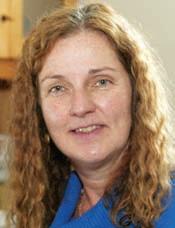
The goal of this work is to find new approaches to augmenting immunity to SIV infection across mucosal barriers. Infection through the mucosal tissue during sex is the primary mechanism for spreading HIV in humans.
Obstacles in the path
The naïve 1980s optimism about developing a vaccine has long since faded. Despite

EMORY HEALTH 16
Candler Professor Bali Pulendran’s research on the immune response has helped identify how individual immune cells produce specific responses to HIV.
Eric Hunter’s research focuses on the
host
and
viral factors involved
in
HIV
heterosexual transmission and early viral disease in African populations, with applications for HIV vaccine development.
Guido Silvestri studies how simian immunodeficiency virus (SIV, a close-cousin of HIV) causes disease in some non-human primates and not in others.
Susan Allen’s research on heterosexual transmission of HIV in Africa has established interventions that reduce its transmission and provide clues for developing a vaccine.
Rafi Ahmed has made significant discoveries about how immune memory cells are created and how long they survive, knowledge that is crucial to developing an HIV vaccine.
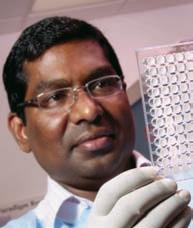

Cynthia Derdeyn investigates how diversity of glycoproteins of HIV’s outer envelope can influence HIV transmission and alter antibody responses to the virus.

TO UNDERSTAND HOW TO INDUCE NEUTRALIZING ANTIBODY RESPONSES IN VIRUSFIGHTING CELLS.
Rama Amara guides a research program aimed at developing both a protective vaccine for uninfected people and a therapeutic one for those already infected by HIV.
progress, the AIDS epidemic is far from being crushed, especially in the developing world.
In wealthy nations, where access to the drugs needed to treat it is usually not a problem, HIV no longer is seen as the threat it once was. In 1995, more than 50,000 Americans a year were dying of AIDS. The yearly death toll now is below 20,000, about the same number of people who die of pancreatic cancer. Nevertheless, nearly 60,000 individuals continue to be infected with HIV in the United States each year.
In developing countries, especially in sub-Saharan Africa, the toll remains dire. In 2010 an estimated 34 million people worldwide were living with HIV/AIDS, about 10% of them children. That same year nearly 2 million people died of the disease. HIV leaves millions of children orphaned and destroys whole communities in poor countries, where it continues to be spread primarily through heterosexual contact.
Even with life-prolonging drugs against HIV, Hunter says, he doesn’t see “any way to treat ourselves out of this disease.” And because public health measures to prevent the disease in developing countries remain woefully underfunded, the demand for a vaccine is greater now than ever.
From the initial hope of developing antiviral medicines like those used against other sexually transmitted diseases to vaccines targeting genes and specific cellular responses, the focus of vaccine research has changed several times, Hunter says. So far, the vaccines
that have made their way into human trials have been only modestly successful.

Following the road not taken
More recently, vaccine researchers have re-focused on the earliest events in the HIV infection cycle, specifically on how the immune system responds to challenges the virus presents. There is some hope, Hunter says, that combinations of agents—and new ways of delivering them (such as Pulendran’s nanoparticle experiments)—will confer a higher degree of protection against the ability of HIV to infect cells and mutate before the body’s immune system can arm against it.
For Cynthia Derdeyn, the new focus takes her back to days as a postdoctoral fellow in Hunter’s laboratory at the University of Alabama at Birmingham (UAB) prior to joining Emory in 2004. It was there that investigators began to realize that the virus that gets transmitted from one person to another may have “special properties” that could be exploited in vaccine development, she says.
“Eight years later, we still don’t know what those special properties are,” Derdeyn says. “And we still don’t have a sufficient understanding of how HIV is transmitted sexually.” She believes the answer lies in part in ongoing research about how the virus is transmitted within heterosexual couples in Africa.
Transmission among homosexual partners was an early focus of HIV research, leading to important discoveries about the virus. More recently, Derdeyn and Hunter turned
their attention to heterosexual transmission in Africa, where distinct variations of the virus are found.
A big part of that research relies on a large repository of health information and reagents compiled by Susan Allen, another UAB-toEmory transplant. Derdeyn and Hunter used samples from Allen’s work in Rwanda and Zambia with “discordant couples”—male and female sex partners, one of whom is HIV positive and the other isn’t—to show that HIV most of the time runs into a genetic bottleneck during heterosexual transmission.
Using the DNA sequences for the gene that encodes a glycoprotein on the outer coat of HIV, the Emory researchers discovered that a single viral variant in each donor established infection in the recipient partner. These transmitted variants are all genetically distinct, but they share properties in their glycoproteins that may make them more vulnerable to a vaccine. These findings suggest that infection may be triggered by specific viral variants more so than by chance.
By understanding these distinct features of the virus, scientists may eventually be able to target them with microbicides or adapt a vaccine that proves much more effective against heterosexual transmission.
“Back in the early 2000s, only a few investigators were really looking at the African viruses,” Derdeyn says. “They were mainly using the data to study transmission linkage between partners from a public health perspective. We decided this was a good opportunity to take a deeper look into what the transmitted virus looks like.”
Thus is the nature of discovery.
At the dawn of the fourth decade of the AIDS epidemic as we know it, perhaps the biggest obstacle in eradicating it lies in acknowledging that we still have a lot to learn.
Winter 2013 17
Why do we still smoke?

We know it’s bad for us, but 19.8% of Americans can’t quit. How Emory is tackling this health hazard.
By Kay Torrance n Illustration Iker Ayestaran
Every Sunday night, I love to watch Mad Men, a drama set in a high-flying, high-pressure New York advertising agency in the 1960s. There are engrossing story lines, snazzy mid-century set designs, and smoke —lots of smoke. The characters smoke at home, in the office, in restaurants. They smoke so much that I wonder how they find their desks through the haze. Today that situation is upended. One would be hard pressed to find an office where ashtrays are commonplace and smoking is allowed. Knowledge about the devastating health effects of firsthand and secondhand smoke has led many to steer clear of cigarettes or to kick the habit.
THE take-away
From statewide programs to individual motivations, Emory researchers are exploring why people still light up and how to get them to stop.
EMORY HEALTH 18

Winter 2013 19
The first U.S. Surgeon General’s report to address smoking and its health hazards was in 1964. The government then jumped in further and required warning labels on tobacco products, raised taxes for cigarettes, and mandated that they be kept behind store counters. It banned television advertising of cigarettes in 1971, followed by billboard ads in 1999. In turn, insurance companies began charging higher medical premiums for smokers and pushed cessation programs. In 1980, the Nonsmokers Rights Movement began to enact smoke-free workplace laws that now prevail in restaurants, bars, and even some casinos. Workplaces—including Emory—have banned smoking on company property, even outside.
All of these moves, Emory researchers say, have led to a decline in smoking. Although it is no longer cool—the Marlboro Man rode off into the sunset years ago—some 19.8% of Americans still smoke, according to the CDC. For this group, no public health or medical intervention has worked—not the cringe-worthy television commercials showing people with advanced-stage lung cancer, not strong health warnings on cigarette packs, not the availability of nicotine patches and gum. Why?
True, national smoke-free policies and high excise taxes levied by some states have failed to reach some of these continuing smokers. The CDC believes that non-smoking interventions should be populationwide and reach throughout large systems of health care. However, to make a big push against smoking, a different approach can help, say Emory researchers. Rather than a typical cessation program that focuses on stress reduction and behavior modification training, smokers need individualized counseling simply because there are vast differences in why different age groups and people smoke.
Emory Provost Claire Sterk, Charles Howard Candler Professor of Public Health, remembers one of her own college professors from the 1980s who used to smoke continuously while he lectured. In all the information about smoking that Sterk gathered over the years, not one study had asked smokers why they smoked or specifically what smoking meant to them. She and colleague Kirk Elifson set out to gather these perspectives to add to the body of knowledge from experts, conducting a study funded by the NIH of smokers from age 18 to 72 to find out why, simply by asking smokers about the meaning of smoking.

The reasons varied from “it helps me relax” to “it gives me energy.” Some only smoked around friends, when under stress, or when figuring out a daily routine. Older smokers tended to be self-deprecating. Younger smokers spoke of their right to do what they wanted. Yet most
of the smokers also mentioned the many times they had tried to quit.
“When smokers have tried to quit eight, nine, or 10 times, it becomes like a mission,” Sterk says. “Smokers stay optimistic that they ultimately will quit. It’s like a revolving door, one that some day they will exit. The reasons they give as to why they continue to smoke make sense to current smokers. But people are not always rational, instead providing justifications for actions they want to change. Otherwise there would be no drunk driving, no obesity.”
Sterk says that the anti-smoking measures that have been enacted so far should not be abandoned. After all, they have helped bring down the smoking rate from more than 40% in 1965. But many of today’s smokers “need interventions that are based on the meaning they attach to smoking. We need to meet people in the place where they are. Having knowledge alone doesn’t mean you are going to act on it,” she says.
THE COMMERCIAL SOFT SELL
One of the hardest subsets to reach may be college students or young adults, says Carla Berg, a behavioral scientist at Emory’s Rollins School of Public Health. Young adults, she has found, are unlikely to consider themselves to be smokers and often rationalize their behavior, making them a difficult group to target.

More than half of college students in her recent study failed to label themselves as smokers. Yet they had smoked at least once in the previous 30 days. Some said they had quit smoking although they had smoked as recently as the day before. If they didn’t think of themselves as smokers, then the idea of quitting seemed irrelevant. Smokers buy cigarettes, some said, but someone who “bums” a cigarette every now and then isn’t a smoker.
Does this parallel how young adults think about alcohol consumption? Probably, Berg says, because they probably drink more than they realize. “But smoking is unlike alcohol, which does have
EMORY HEALTH 20
TWO APPROACHES TO SMOKING INTERVENTIONS (L TO R): CLAIRE STERK and KIRK ELIFSON, with funding from the NIH, are exploring smokers’ perceptions of why they smoke; CARLA BERG is testing anti-smoking commercials geared to college students, a tough group to target about smoking.
PHOTO BY BRYAN MELTZ
some health benefits. There is no safe level of tobacco use.”
Berg, who also is helping to develop a traditional cessation program for cancer survivors at Emory’s Winship Cancer Institute, is currently testing humorous anti-smoking commercials geared to college students. The story lines play off of what students value, such as being socially accepted or perceived as physically attractive. There is no preaching, no finger pointing, no graphic images. “One thing that we are trying to show is that it’s no less disgusting if you only smoke when you are drinking than if you smoke all the time,” she says.

PROTECTING CHILDREN
Other research is sidestepping the issue of quitting and focusing on secondhand smoke instead. Michelle Kegler, director of the Emory Prevention Research Center, along with Berg and colleague Cam Escoffery, is working with United Way of Greater Atlanta to ask smokers to commit to smoking only outside. Families who call United Way’s 2-1-1 helpline and have at least one smoker in the home can enroll voluntarily in the study. They receive three mailings and one counseling phone call to help them develop a “no-smoking” zone inside the home, including how to address challenges such as a resistant smoker.
“Many of these families have children, and this is one way of protecting them,” Kegler says. “The home is the No. 1 place for secondhand exposure among children. We are reinforcing a norm that smoking is bad for health. This program is another social force to discourage smoking.”
Kegler thinks the program’s structure is key to its potential success. There are no long counseling sessions to attend, and the smoker is not being asked to quit. “It’s a quick and easy intervention,” she says.
In the study’s first group of 40 households, 100% allowed smoking inside at the beginning of the program. At the program’s completion, 33% had totally banned smoking inside. Smokers reported smoking fewer cigarettes per day, and 65% of them reported trying to quit. Kegler expects 5% to 10% of smokers in the study will quit in the long-term. That’s not a very high rate, she says, but finding new ways to help smokers quit permanently is an ongoing public health challenge.
Kegler agrees that current anti-smoking measures are working, particularly cigarette taxes, which have been shown to ward off young people from smoking. While cessation programs are valuable for current smokers, she says, public health interventions have changed social norms around smoking and have prevented many people from taking that first puff.

Taking on tobacco control, state by state

To help state and local governments with tobacco control programs, Emory’s Rollins School of Public Health created the Tobacco Technical Assistance Consortium (TTAC) in 2001. TTAC provides training to federal, state, and community agencies to implement population-based tobacco control programs and policies. Its efforts range from grassroots messaging to training personnel to evaluating a program’s effectiveness. In one example, TTAC is working with the South Dakota Department of Public Health and nine American Indian tribes to develop tribal policy toolkits to help reduce the influence of tobacco in tribal communities. Recently, the organization has worked with health departments in Oklahoma, Mississippi, Louisiana, Texas, and Indiana to engage state-wide partners in a unified campaign to reduce tobacco use. In the U.S. Virgin Islands, it gave input on a tobacco control policy that even the tourist-dependent casinos could live with, says TTAC Director Debra Morris. One common adversary that smoking control programs face is Big Tobacco, which spends more than $8 billion annually to promote its products, especially to young people. TTAC also helps states and communities counter the tobacco industry push with proven policies and programs that we know work, Morris says.
For additional information, see TACenters@emory.edu
Winter 2013 21
PHOTO BY KAY HINTON
MICHELLE KEGLER is working to reduce second-hand smoke in the home.
Q&A HPV ON

Does getting an HPV vaccine to prevent cervical cancer increase sexual promiscuity in adolescent girls?
What is causing a surge in HPV infections associated with head and neck cancers in white men?
Will an HPV vaccine received at age 11 last long enough to protect women in their 40s when cervical cancer tends to strike?

EMORY HEALTH 22
IBy Quinn Eastman n Illustration by Lorraine Tuson
In the fight
against





HPV, Emory gynecologist Kevin Ault is taking the long view. Most cervical cancers are caused by two varieties of HPV (human papillomavirus), and a vaccine approved in 2006 can protect against both of them. Still, the longterm effectiveness of the vaccine is unknown.
Emory researchers are answering important questions about HPV and its controversial vaccine.

Winter 2013 23
take-away
THE
“Let’s say a girl in her early teens, someone like my daughter, gets the vaccine,” Ault says. “But the average age of diagnosis for cervical cancer in the United States is the early 40s. The vaccine’s shield has to last for decades for it to actually protect her against disease.”
HPV itself is a wily adversary. Most people who become infected with HPV do not know that they have it. At least 80% of sexually active men and women carry the virus at some point in their lives, but in most cases, the immune system clears the virus from the body. Researchers have found that the virus hides in “crypts” in the cervix, anus, tonsils, base of tongue, and throat. More than 40 types of HPV can infect both men and women. Two types, HPV-16 and HPV-18, have been shown to cause cervical cancer, as well as most anal cancers and some vaginal, vulvar, penile, and head and neck cancers.
Ault is leading an NIH-funded study at Emory that looks at how long vaccine recipients maintain “immune memory.” That is, how long does the immune system stay ready to fight the virus after receiving the vaccine? Study participants are healthy women between the ages of 18 and 26, who

will be followed for three years. The research takes into account women who have received two rather than the recommended three doses of the HPV vaccine.
Ault says recent findings about the pertussis vaccine may shed light on the long-term effectiveness of the HPV vaccine. In the 1990s, children in the United States began receiving a newer version of the pertussis vaccine that had fewer side effects than the original version. Researchers at Kaiser Permanente recently showed that immune protection fades faster with the newer vaccine, waning substantially five years after the last shot. They suggest that this lack of protection may be a contributing factor in the largest reported outbreak of pertussis in 50 years, which occurred in 2012.
“We wouldn’t want people to rely on something that lasts a relatively short time,” Ault says. His study will give clues on whether patients will need periodic HPV booster shots, like those for tetanus.

What do Georgia parents think?
In 2007, the CDC recommended that girls receive the HPV vaccine as a preventive measure at age 11 or 12. A few states instituted mandates requiring HPV vaccination for school attendance, but these requirements generated controversy. Some political and religious leaders believed that HPV vaccination was inappropriate for girls, arguing that it would encourage sexual behavior.

Since then, Robert Wood Johnson Foundation Nurse Faculty Scholar Tami Thomas has been probing the attitudes of parents about the HPV vaccine in three rural counties in eastern Georgia. The counties were chosen because of their low HPV vaccination rates (less than 18%), as well as relatively high rates of cancer and poverty. By comparison, 53% of adolescent girls in the United States have received at least one dose, and 35% have received all of the recommended three, according to the CDC In Georgia, those numbers are 48% and 30%, respectively.
With the support of the Robert Wood Johnson Foundation and the National Insti-
tute of Nursing Research, Thomas has surveyed more than 500 parents and conducted focus groups about attitudes toward the vaccine. She began in 2009 by working with church and school leaders to establish relationships and gain the trust of local parents.
“We found a lack of information and lots of misinformation,” Thomas says. “Some people didn’t know there was an HPV vaccine, and some didn’t know it could prevent these types of cancer.”
Among her findings, cost or distance parents had to travel to have their child vaccinated were two barriers. Health providers who were suspicious of the HPV vaccine had discouraged parents from having their children vaccinated. And some parents questioned why it was necessary to vaccinate girls and boys in their early years.
“I tell them, ‘this is a preventive vaccine, just like many other vaccines that prevent illness in adulthood,’” Thomas says.
Ironically, Thomas’ research on the attitudes of rural Georgia parents indicates that there may be less resistance to the idea of HPV vaccination for boys. The CDC added the recommendation that adolescent boys receive the vaccine in 2011.
Thomas is working with CancerQuest to craft educational materials tailored for parents. “These parents all love their kids and want the best for them, but the problem is making sure that they receive unbiased infor-
EMORY HEALTH 24
Kevin Ault examines how long vaccine recipients maintain immune memory.
mation,” Thomas says. “I try to be the conduit of accurate, reliable information, rather than the imposing authority myself.”
To that point, Emory vaccine researchers recently teamed up with Kaiser Permanente to examine clinical markers of sexual activity in girls who had received the HPV vaccine. Although previous studies surveyed girls about behavior, this study—published in Pediatrics in October—was the first to look at concrete outcomes. The study included almost 1,400 girls, aged 11 or 12, who were Kaiser Permanente members in Georgia in 2006 and 2007 (in the first 18 months after the HPV vaccine became available).
“Our study found a very similar rate of testing, diagnosis, and counseling among girls who received the vaccine and girls who did not,” says Emory epidemiologist Robert Bednarczyk, who holds a joint appointment at Kaiser as an affiliated clinical investigator. “We saw no increase in pregnancies, sexually transmitted infections, or birth control counseling—all of which suggest the HPV vaccine does not have an impact on increased sexual activity.”
A link to head and neck cancer?

Evidence is emerging that HPV infection also is contributing to head and neck cancer. In a 2011 article published in Oncology, researchers at Emory’s Winship Cancer Institute reported a “surge” in the past two decades
of HPV-related tumors in the tongue and tonsils, especially among white men. Part of the increase is due to more sophisticated and intentional ways of looking for HPV, says Emory oncologist Jonathan Beitler.


“Ten years ago, it was not a perceived problem, but our world has changed,” he says. “This used to be a disease of older men, smokers, and drinkers. Now we are seeing patients who are younger and more educated, without those traditional risk factors.”
Beitler estimates that three-quarters of the patients he sees with head and neck cancer have HPV-related tumors. The surge may be connected to increased practices of oral sex and/or marijuana consumption.

For example, having six or more oral sex partners increases a person’s risk of developing head and neck cancer nine-fold, amounting to more than the increased risk coming from smoking.
On a brighter side, patients who have HPV-related tumors generally have better outcomes than those whose tumors have a different origin. The survival rates of these patients are higher, with five-year survival rates of 75% to 80%, compared with 50% for HPV-negative tumors.
The higher survival rates and younger patient profiles mean that oncologists treating
head and neck cancer are trying approaches such as minimally invasive surgery and drugs that may have fewer side effects. “Our current challenge is figuring out how to de-intensify therapy in the best way and still cure the patient,” Beitler says. “We want to make it possible for patients to get back to their lives.”
In a national clinical trial in which Beitler is involved, researchers are comparing two

anticancer drugs to treat head and neck cancer in combination with radiation. One approach uses a standard DNA-damaging agent, cisplatin, with the test drug, cetuximab, to block a growth factor found on head and neck cancer cells. The aim is to determine whether cetuximab can provide the same level of efficacy with reduced side effects, such as mouth sores. The investigators also hope to learn about the genes of the HPV varieties that contribute to activity in head and neck cancer.
Beitler notes that HPV varieties may continue to shift, indicating that vaccine studies like Ault’s could guide updates in vaccine practices for both men and women.
Winter 2013 25
Tami Thomas has probed attitudes about the HPV vaccine among parents.
Robert Bednarczyk examined whether getting an HPV vaccine impacted sexual activity.
Jonathan Beitler is researching the connections between HPV and throat and neck cancer.
Throat and neck cancer “used to be a disease of older men, smokers, and drinkers. Now we are seeing patients who are younger and more educated, without those traditional risk factors.”
Interpreting health
 By Rhonda Mullen
By Rhonda Mullen
When Eduardo Garcia was growing up, in El Paso, Texas, he often went with his grandmother to her doctor’s appointments to help interpret for her. Having recently emigrated from Mexico, Garcia’s grandmother was still learning English, and her young grandson would give her the highlights of what the doctor was saying. However, these years later as a chemistry major at Emory, Garcia realizes that his attempts at interpretation were flawed. “I should have translated word for word,” he says. “And some things were too personal to communicate. The situation needed an unbiased third party who could interpret.”
Emory student volunteers are improving health care, one word at a
Garcia’s insights come after more than two years of working to help establish the Emory University Volunteer Medical Interpretation Services (EUVMIS). One of the first service-learning programs in the country to train graduate and undergraduate students as medical interpreters, EUVMIS grew out of observations by medical students and undergraduates who volunteered at free clinics in Atlanta. There never seemed to be enough medical interpreters to go around at these primary care clinics that serve a diverse and international community of the working poor.
The medical students who ran the clinics played catch as catch can and drew in anyone with foreign language skills—particularly in Spanish—to help. But untrained, ad hoc interpreters have error rates that average between 50% and 75%, according to Howard Chiou, an MD/PhD student who banded with other students from throughout Emory’s graduate and undergraduate schools to see if they could marshal the resources to meet the big need.
These two years later, after two pilot phases, hours of consulting with legal counselors, developing partners with professional training groups and local clinics, fundraising for program support, and overcoming what the students say was a “huge learning curve,” EUVMIS
is officially launched. Supported by a threeyear seed grant from the Office of the Executive Vice President for Health Affairs in the Woodruff Health Sciences Center and funding from the anthropology department’s Global Health, Culture, and Society program, the EUVMIS also has formalized a three-year commitment by Grady Memorial Hospital’s Department of Multicultural Affairs to give the student volunteers practical training in medical interpretation.
“The EUVMIS project is a much needed program,” says Sandra Sanchez, who directs multicultural affairs at Grady. “It will address language barriers and especially benefit those health organizations that serve low-income, uninsured, and homeless patients in Atlanta.”
Beyond literal translation
The EUVMIS has proven popular (and competitive) among students. Its leadership core is made of students from medicine, business, anthropology, chemistry, and Spanish. Volunteers—both students and faculty mentors—come from across the university and the health sciences. The multidisciplinary focus is intentional, says business
EMORY HEALTH 26 SE HABLAS ESPAÑOL Found in translation
THE take-away
time.
major Kristin Rebescher, one of the leadership team. “We are all on the same team to play on people’s strengths to minimize social disparities in health care.”
The participation of undergrads also lends continuity and sustainability to the program, says Duncan Wilson, a third-year medical student who got involved with the program specifically because he wanted to work with the undergraduates to harness their passion. “This is an energized group that is investing their time for all the right reasons,” he says. “It’s nice to hear their take on things and a refreshing break from medical school.”
To be chosen for one of the training slots each semester, students start the application with a panel interview that assesses commitment and performance. They also are asked to pay for a portion of their tuition ($200) to help cover the costs of training.
The first semester involves a series of Saturday classes through Cultural Connect, a nonprofit organization that fosters cultural fluency and has a long track record in training interpreters. Led by Executive Director Alexis Dalmat, a current Executive MBA student at Emory, Culture Connect also offers a language services program
that is contracted by Emory Healthcare. Classes go well beyond literal translation to cover communication skills, cultural norms, patient safety, and professionalism, among other topics. In the end, students receive certificates of proficiency accredited by the International Medical Interpreters Association.


Next, students progress to coaching and practical training from professional interpreters in Grady’s Multicultural Affairs department. They start with shadowing an interpreter, then progress to first a supervised practicum, then unsupervised interpretation encounters with patients, all followed by debriefing and coaching sessions with the professionals. On completion of their training, they will be ready to help staff community partner clinics with quality interpreters.
The participants say that being part of the EUVMIS group has been transformative. Trisha Patel, a fifth member of the leadership team and an anthropology and Spanish major who is applying to medical school this year, says, “I thought before that poverty was the main barrier to access to care, but I’ve come to realize that linguistics can be a big hindrance too. No matter where I end up in the future, I want to address linguistic barriers to care and do my part to minimize social disparities in health care.”
Chiou never anticipated how long it would take to jump all the hurdles inherent in getting a new organization up and running. But from working for nine months with Emory’s legal counsel to get agreements just right to navigating the hurdle of getting identification badges for students at Grady, he’d do it all over again. “This is one of the most rewarding things that I’ve ever worked on,” says Chiou. “I’ve learned so much about improving health care and how to create the care structures that we so desperately need.”
Winter 2013 27
The student founders of Emory University’s new volunteer medical interpretation program are (l to r): Howard Chiou, Trisha Patel, Eduardo Garcia, Kristin Rebescher, and Duncan Wilson.
Breast



cancer is the most common

cancer
diagnosed in women. The National Cancer Institute estimates that about one in every eight women will face a breast cancer diagnosis. But one Atlanta family is stepping up to combat those odds. Two gifts totaling $10 million from the Wilbur and Hilda Glenn Family Foundation will fund and name the Glenn Family Breast Center at Emory’s Winship Cancer Institute. The gifts allow Winship to expand its tumor bank, clinical trials, community access, and multidisciplinary approaches to screening and caring for women at high risk for breast cancer.

EMORY HEALTH 28 THE LAST WORD
Tie a pink ribbon
© 2013 Photo Researchers, Inc. All Rights Reserved.
Pictured: a scanning electron microscopy of a breast cancer cell.
Be the first to read about
the latest research discoveries from Emory brand-new innovative treatments for patients Emory experts weighing in on national health topics.
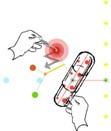
How? Subscribe to Emory Health online. For a free quarterly subscription, visit emoryhealthmagazine.emory.edu/subscribe/index.html.
Editorial Advisory Board

Chair

RAY DINGLEDINE, PHD
Professor and Chair of Pharmacology and Executive Associate Dean for Research, Emory University School of Medicine


Ex officio chair


ROBERT GODDARD III, Chairman and CEO, Goddard Investment Group
Membership
CHARLES CRAIG, President, Georgia Bio
LAURA HURT, RN, Director of Nursing Operations, Emory University Hospital Midtown
LUCKY JAIN, MD, Professor of Pediatrics, Emory
CLAIRE PERDUE JAMES, philanthropist
MICHAEL M.E. JOHNS, Emeritus Executive VP for Health Affairs, Emory
JEFF KOPLAN, MD, MPH, Vice President, Global Health, and Director, Global Health Institute, Emory
SANDRA MACKEY, Executive Director, Marketing Strategy & Support, Emory Healthcare
KIMBERLY MANNING, Assistant Professor of Medicine, Emory
PAUL PENDERGRASS, independent communications consultant, Typing Inc.
JULIE RALSTON, Director of Communications, Atlanta Regional Commission
WALKER RAY, MD, retired pediatrician, former president of the Emory Alumni Association, member of Campaign Emory School of Medicine Committee
BILL TODD, Executive Director for Health Care Initiatives, College of Management, Georgia Institute of Technology
To see your business here, advertise in Emory Health

If you have a business, service, or opportunity that you’d like to promote, an ad in Emory Health will enable you to reach an educated and affluent audience of 56,000 readers (including Emory donors and friends, visitors to our hospitals and clinics, community neighbors, the 18,000 employees of the Woodruff Health Sciences Center, and Emory alumni in medicine, nursing, and public health).
For more information and rates, visit whsc.emory.edu/ advertising, or e-mail david.mcclurkin@emory.edu.
Winter 2013 29
Sustaining Haiti Diabetes interventions 14 Delivering nanotechnology packages 16 Chasing the blues Emory is on a mission to change perceptions that depression is a normal part of aging 2 Modeling the CDC 8 Emory goes to high school 12 C-section spikes 16 MMOLECULAR ATCH GAME Emory chemists and clinicians are changing the drug discovery process—and potentially changing the world as we know it. Against all odds Getting product to the medical marketplace needs Survivor Grady community helped keep the hospital doors open Reach out and touch For an AT&T exec, the slogan has new meaning 2 health Summer 2008 Woodruff Healt ScienceS The Body Revealed Seeing disease sooner and smarter
Emory University
Woodruff Health Sciences Center
1440 Clifton Road, 1st floor, 150M Atlanta, Georgia 30322
Address Service Requested
Have a plan.
AS A LIGHTING-INDUSTRY EXECUTIVE and an amateur photographer, illumination has been an important component of Charles Darnell’s personal and professional lives.

When a serious eye condition threatened his vision, he sought expert care at the Emory Eye Center. After successful treatment, Darnell became involved with the center’s advisory board and has helped design lighting for renovated treatment rooms and offices at the center. To show his appreciation, Darnell also has made a bequest to support research and patient care at the center.“People who lose their sight lose a whole world,” he says.
To learn how you can support medical research and patient care with an estate gift, call Emory’s Office of Gift Planning at 404.727.8875 or visit www.emory.edu/giftplanning.
Plan to illuminate .








 Download our iPad app.
Download our iPad app.









 Brigette Ulin
Acting Director, Office of National Prevention Strategy Centers for Disease Control and Prevention
Brigette Ulin
Acting Director, Office of National Prevention Strategy Centers for Disease Control and Prevention















 By Dana Goldman n Photography Jack Kearse
By Dana Goldman n Photography Jack Kearse










































 By Rhonda Mullen
By Rhonda Mullen











